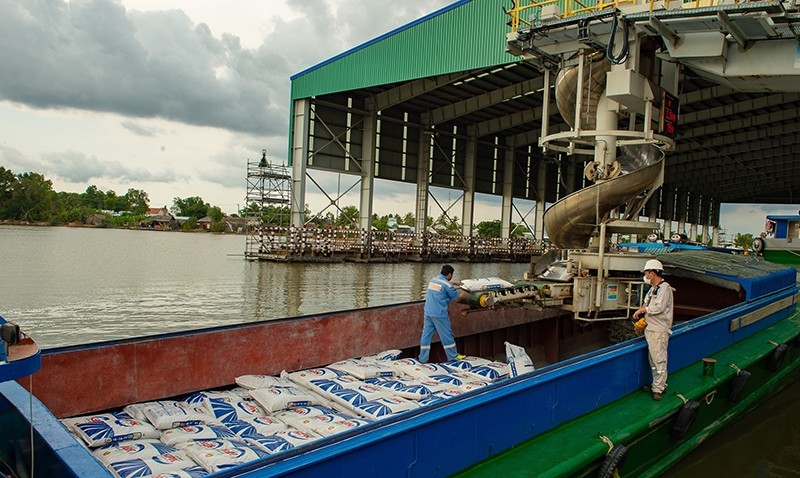Fertilizer oversupply in domestic market
Currently, there are four fertilizer factories in Vietnam, including: Phu My, Ca Mau, Ninh Binh and Ha Bac, producing about 2.5 million tonnes of urea per year, consuming about 1.8 million tonnes per year, oversupplying 500,000 tonnes per year, but with urea imports still increasing, factories have had to find ways to export the excess urea.
According to Nguyen Thi Hien, Deputy General Director of Petro Vietnam Ca Mau Fertilizer Joint Stock Company (PVCFC), facing the situation of fertilizer oversupply in the country led to high inventories, and the PVCFC was looking for markets to export to.
On January 13, 2013, the first batch of Ca Mau fertilizer was exported to the Philippines. In 2014, the PVCFC officially began participating in the export market, especially the Cambodian market.
Deputy General Director Hien said that due to close geographical conditions, low logistics costs, Cambodia is considered the leading market of PVCFC. Currently, PVCFC has six level 1 agents, four distributors and two commercial agents. Every year, the distribution system in Cambodia consumes from 80,000 to 130,000 tonnes.
Since 2011, when Ca Mau's urea plant went into operation, Vietnam’s urea market has had an oversupply of 500,000 tonnes (supply of 2.2 million tonnes - demand of 1.8 million tonnes). Because the logistics costs from the location of the fertilizer plant in Ca Mau to the markets in the Southeastern nation, the Central Highlands and Northern regions ire more expensive than Cambodian market, so PVCFC identified Cambodia as the target market to penetrate, Hien said.
Since 2014, after running for two years, the inventories of domestic urea producers were all high (oversupply of 500,000 tonnes), so any factory that could afford it had to look for export markets, and reduce inventories and oversupply at home, so that their selling price was not below cost.
Hien shared: “In March and April 2020, PVCFC stocked up to 200,000 tonnes because farmers in the Southwest region abandoned their 3rd crop, and the price of urea dropped to VND 5,900 per kilogramme (at that time this price was lower than production cost by VND200 to VND300 per kilogramme). Besides this, Cambodian farmers also quit their crop, so we had to go to the African market to sell the goods."
Fertilizer exports see strong growth
In addition to ensuring the supply of fertilizers for the domestic market, PVCFC has also been constantly searching and expanding its market to countries both in the region and around the world. Accordingly, export volumes and value saw growth every year, contributing to the development targets of the company in particular and the export targets of Ca Mau province in general.
In particular, Cambodia, with its geographical advantages and similarities in season with the Mekong Delta region of Vietnam, was identified by the company as an important target market. In the first five months of this year, total consumption of all kinds of fertilizer products in the Cambodian market reached approximately 63,000 tonnes, 96% of the plan, increasing 20% over the same period in 2020.
Nationwide, according to the latest statistics from the General Department of Vietnam Customs, from the beginning of the year to June 15, fertilizer exports reached 615,710 tonnes, earning US$212,867 million, up 49% in volume and 1.76 times in value over the same period last year. This was the first time in history that fertilizer exports reached this record high number. Export fertilizer prices in May increased slightly by 0.9% as compared to April and 14% compared to May 2020, reaching an average of US$342.3 per tonne. In the first five months of this year, export prices also increased by nearly 11% over the same period in 2020, reaching US$322 per tonne.
Vietnam's fertilizer is mainly exported to Cambodia, accounting for 37% of the total volume and 39% of the country's total fertilizer export turnover in the first five months of this year, or 214,136 tons, equivalent to US$72.7 million, a strong increase of 63.3% in volume and 76.5% in turnover. The price also increased by 8.1%, reaching US$339.5 per tonne.
Fertilizer export to Malaysia reached 41,293 tonnes, earning US$8.6 million, with the price at US$208.2 per tonne, decreasing in both volume and value, but the export price increased by nearly 23%.
Meanwhile, fertilizer export to Laos reached 24,330 tonnes, equivalent to US$8.98 million, accounting for more than 4% of the country's total fertilizer export volume and turnover, up 9.3% in volume and 4.3% in value, but the price decreased by 4.5%, reaching only US$369 per tonne.
Notably, fertilizer exports to the Philippines and Mozambique markets, although turnover has not been large, has seen strong growth.
The reason the amount of fertilizer exported in the first five months of the year increased sharply compared to the same period last year, is that in the end of 2020, the fertilizer market in 2021was forecast to continue to be subdued with a high inventory of goods, and the possibility of the recurrence of natural disasters, such as drought in the Southwestern, Southeastern - Central Highlands regions, as well as floods in the Northern region.
However, due to the prolonged Covid-19 epidemic, the trend of crop conversion in the Southwestern region has had a significant impact on the production and business plans of units in the industry. Therefore, from the end of 2020, some fertilizer manufacturers signed a number of export contracts for delivery in the first quarter of 2021, to reduce their inventories and balance domestic supply and demand.
















